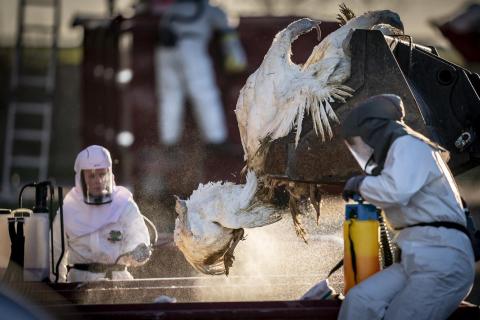Man infected with H5N2 avian influenza virus dies in Mexico
The World Health Organisation (WHO) has announced that a 59-year-old man infected with the H5N2 avian influenza virus died in Mexico on 24 April. This is the first confirmed human infection with the virus. The patient had multiple underlying medical conditions and had been bedridden for three weeks for other reasons before showing symptoms. The source of infection is unknown. The WHO assesses the risk to the general population as low.

Ian Brown - H5N2
Ian Brown
Avian Virology Group Lead, Pirbright Institute
The H5N2 in Mexico belongs to a distinct family of H5 viruses known to have been circulating in local birds for some time and is therefore quite different from other H5s causing sporadic human cases. It is not without precedent that we see very occasional reports of the detection of influenza A viruses from birds in severe human cases when there are major underlying health issues. The role of this virus in the fatal outcome cannot be assumed to directly responsible without further investigation. The prompt follow up in healthcare professionals and family members in contact with the infected patient provides reassurance at present this is an isolated case.
Ian Jones - muerto México gripe aviar EN
Ian Jones
Professor of Virology, University of Reading
It is impossible to generalise from a single case. However, as H5N2 is present in Mexico and the infected individual had underlying medical conditions, which may have contributed to the outcome, it would be reasonable to suppose this is a one-off case of zoonotic transfer with no potential to spread. This would be consistent with previous examples of occasional avian influenza infections in people. Unless or until there is evidence of strain adaptation or sustained transmission, the risk to the population is very low. The case should act to reinforce the importance of monitoring and eradicating outbreaks in poultry as soon as they occur.
Ed Hutchinson - muerto México gripe aviar EN
Ed Hutchinson
,Senior Lecturer, MRC-University of Glasgow Centre for Virus Research (MRC CVR)
At a time when many people’s attention has been focused on H5N1 influenza in cattle in the USA, this case is a reminder that there are lots of other influenza viruses out there that also have the potential to infect humans. However, it is important to stress that at the moment this case was a sad but isolated incident. At the moment there is no suggestion that this particular influenza virus has spread any further in humans.
Details of the case are still emerging, but at the moment we know that the virus was an H5N2 influenza virus, making it distinct from the H5N1 influenza viruses that are currently spreading in cattle in the USA and in birds worldwide. Influenza viruses can exchange genes with each other, but whether or not that’s happened here will only become clear when viral sequence data are available. For now, we know that there have been recent outbreaks of H5N2 influenza viruses in poultry in Mexico, suggesting that this case may have been related to one of those.
Exactly how the person became infected is not yet known, but although there was no record of contact with poultry this sounds like it was most likely a “spillover” infection, in which a virus that was adapted to one species of host manages to infect a member of another species (in this case a human), but is not able to transmit any further. It’s probably significant that the person in question had multiple underlying health conditions, and had been very unwell for some time before showing signs of this infection. This is likely to have made it easier for a virus that normally grows in birds to infect them, and unfortunately it may also led to them experiencing severe disease when they became unwell. It’s not yet clear if the virus had to undergo any particular changes to replicate in this person (something that would definitely be required if it was to spread further in humans). This should become clearer if the virus’ genes can be sequenced and compared to other similar viruses.
At the moment surveillance is taking place, including testing people who may have been exposed to the virus but fought off the infection to see if they show any signs of an immune response. If there are more human infections with this virus it would become of wider concern, but for now it is a very sad but isolated case.
"I have received honoraria for work in a steering group of the Centre for Open Science (Open Practices in Influenza Research; 2021-2022) and on an advisory board for Seqirus (2022). I have unpaid positions on the board of the European Scientific Working group on Influenza and other respiratory viruses (ESWI) and as a scientific adviser to PinPoint Medical".



